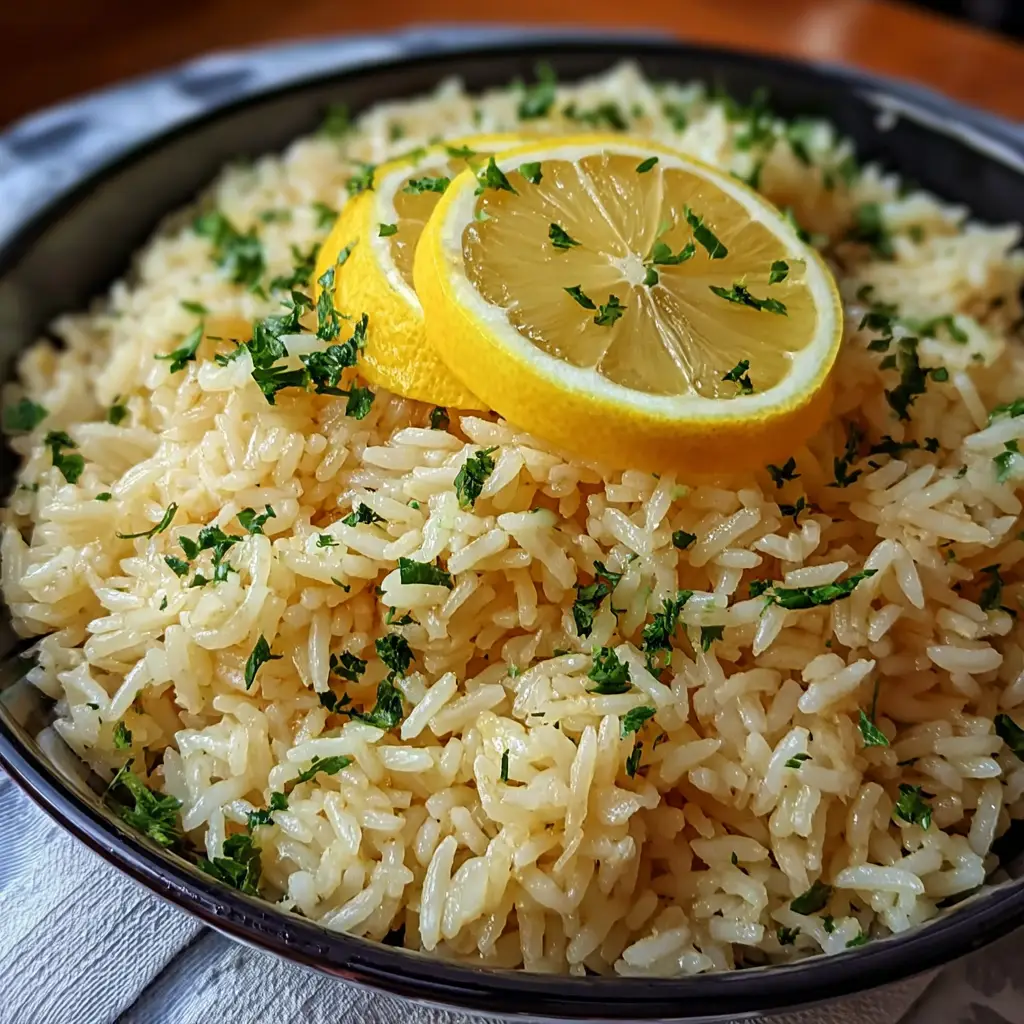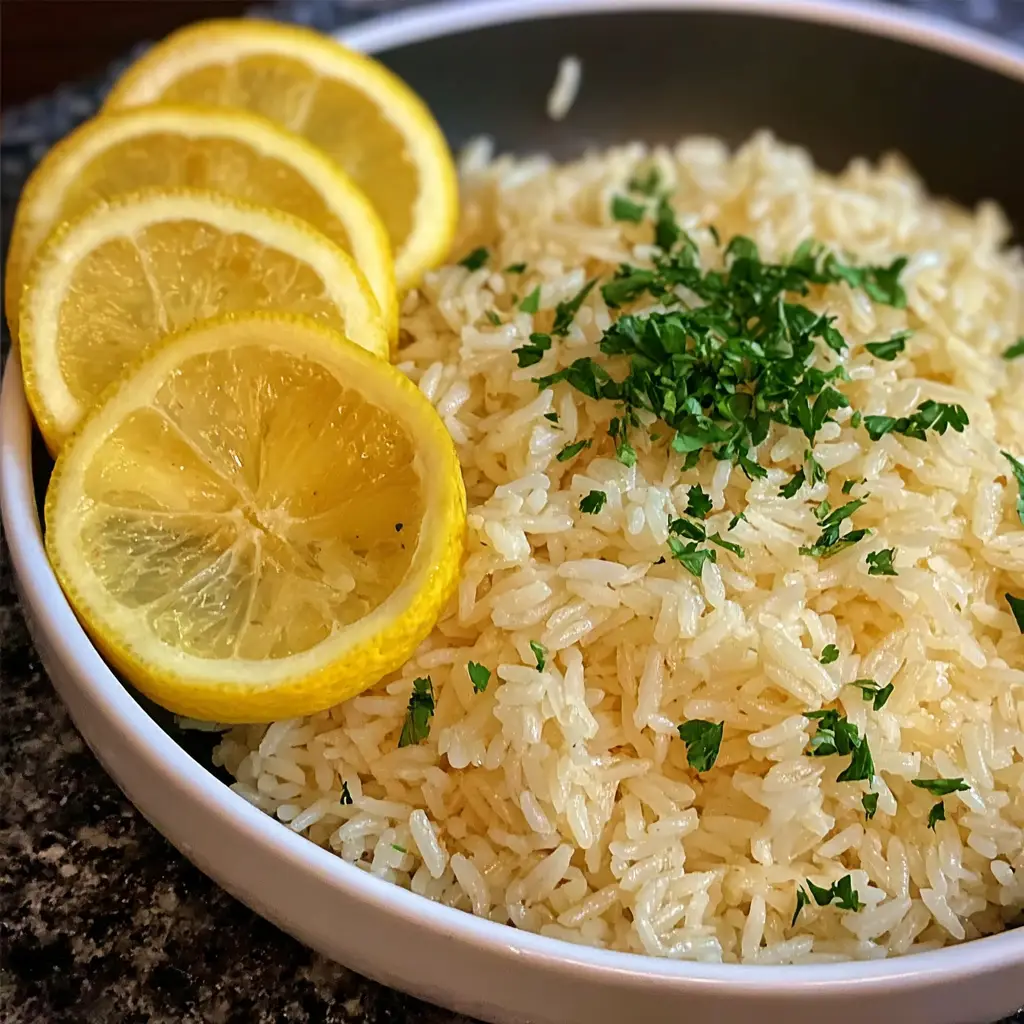| Prep Time: 10 minutes | Cook Time: 25 minutes | Total Time: 35 minutes | Serves: 6 |
|---|
Transport your taste buds to the sun-soaked shores of the Mediterranean with this authentic Greek lemon rice recipe that transforms ordinary grain into an extraordinary culinary experience bursting with bright citrus flavors, aromatic herbs, and the essence of traditional Greek hospitality because every forkful delivers the perfect balance of tangy lemon, fragrant dill, and fluffy rice that has graced Greek tables for generations. This beloved dish, known as “rizi lemonato” in Greece, represents far more than just a simple side dish because it embodies the fundamental principles of Mediterranean cooking where fresh, quality ingredients are allowed to shine through minimal yet masterful preparation techniques that create complex flavors from surprisingly simple combinations of olive oil, garlic, herbs, and the starring ingredient that gives this dish its distinctive character and irresistible appeal.
Why Greek Lemon Rice Will Transform Your Dining Experience
This exceptional Greek lemon rice stands as a testament to the genius of Mediterranean cuisine because it demonstrates how a few carefully selected ingredients can create flavors that are both sophisticated and comforting, elevating humble rice from a mere starch to the star of the meal. The magic lies in the traditional pilaf cooking method that begins with sautéing aromatic vegetables in golden olive oil before adding the rice, allowing each grain to absorb these foundational flavors because this technique creates depth and complexity that simple boiled rice could never achieve.
What makes this particular version so special is its perfect balance of bright acidity from fresh lemon juice, earthy richness from extra virgin olive oil, and the distinctive Mediterranean herb combination that defines authentic Greek cooking because these elements work together harmoniously to create a dish that can stand alone as a light meal or complement virtually any protein without overwhelming other flavors. The preparation process itself is deeply satisfying because it fills your kitchen with the intoxicating aromas of garlic, herbs, and lemon that immediately transport you to a Greek taverna overlooking the azure Aegean Sea.
The versatility of Greek lemon rice makes it invaluable for both everyday family dinners and special occasions because its elegant presentation and sophisticated flavors belie the simplicity of its preparation, making it perfect for busy weeknights when you want something special without spending hours in the kitchen. The bright, clean flavors also make it an ideal choice for health-conscious diners because it relies on fresh herbs and citrus rather than heavy sauces or excessive fats to deliver maximum flavor impact while remaining naturally light and nutritious.
Essential Ingredients for Perfect Greek Lemon Rice
For the Rice Base:
- 1 1/2 cups long-grain white rice (such as basmati), providing the perfect texture
- 3 tablespoons extra virgin olive oil, delivering authentic Mediterranean flavor
- 1 medium yellow onion, finely diced, creating aromatic foundation
- 3 cloves garlic, minced, adding pungent depth
- 3 cups chicken broth (or vegetable broth for vegetarian version), enriching the rice
- 1/4 cup fresh lemon juice (from 2-3 lemons), providing signature brightness
- 1 teaspoon salt, enhancing all other flavors
- 1/2 teaspoon black pepper, adding subtle warmth
For the Fresh Herb Finish:
- 1/4 cup fresh dill, chopped, contributing distinctive Greek character
- 1/4 cup fresh parsley, chopped, adding color and freshness
- Zest of 1 lemon, intensifying citrus aroma
- 2 tablespoons butter (optional), for added richness
- Additional lemon wedges, for serving and extra brightness
The Art of Creating Perfect Greek Lemon Rice
Mastering the technique of authentic Greek lemon rice requires understanding the fundamental principles of pilaf cooking because this method ensures that each grain remains separate and perfectly tender while absorbing maximum flavor from the aromatic base and seasoned broth. The key to success lies in proper preparation of the rice through washing and soaking because this removes excess starch that could create a gummy, unappetizing texture that would compromise the light, fluffy result that characterizes exceptional Greek rice dishes.
The foundation of exceptional flavor begins with the soffritto, the aromatic base of sautéed onions and garlic cooked in high-quality olive oil because this creates the flavor platform upon which all other elements build, and rushing this step or using inferior oil will significantly impact the final result. Temperature control throughout the cooking process is crucial because the goal is to achieve gentle, even cooking that allows the rice to absorb the seasoned broth gradually while developing the characteristic texture that makes Greek lemon rice so appealing and satisfying.
The timing of when to add the fresh herbs and lemon juice is critical because these bright, volatile flavors can be damaged by excessive heat, so they must be stirred in after cooking when the rice is still hot enough to release their aromatic oils but not so hot as to destroy their fresh, vibrant character. Understanding these nuances separates good Greek lemon rice from truly exceptional versions that capture the authentic flavors of traditional Greek cooking.
Step-By-Step Instructions for Greek Lemon Rice Excellence
Step 1: Prepare the Rice
Rinse the rice in a fine-mesh strainer under cold running water until the water runs clear, then soak it in cold water for 10-15 minutes before draining thoroughly because this removes excess surface starch that could make the rice sticky and ensures each grain cooks evenly and remains separate in the finished dish.
Professional Tip: The rice should break easily between your thumb and finger after soaking because properly hydrated rice cooks more evenly and reduces the likelihood of undercooked or mushy grains that can ruin the texture.
Key Points: Proper rice preparation is the foundation of success because skipping this step often results in gummy, clumped rice that lacks the light, fluffy texture that defines authentic Greek lemon rice.
Step 2: Create the Aromatic Base
Heat the olive oil in a large, heavy-bottomed saucepan over medium heat until shimmering, then add the diced onion and cook for 3-4 minutes until softened and translucent, stirring occasionally to prevent browning because the goal is to develop sweetness and aroma without creating any bitter caramelized flavors.
Professional Tip: Use high-quality extra virgin olive oil because it provides the authentic Mediterranean flavor that defines Greek cuisine, and inferior oils can create off-flavors that compromise the entire dish.
Key Points: The onions should be translucent but not browned because excessive browning introduces bitter compounds that would interfere with the bright, clean flavors that characterize exceptional Greek lemon rice.
Step 3: Build Flavor Depth
Add the minced garlic to the softened onions and cook for 30-60 seconds until fragrant, stirring constantly to prevent burning, then add the drained rice and stir continuously for 2-3 minutes until the grains are well-coated with oil and beginning to turn slightly translucent because this toasting step is crucial for developing the nutty undertones that add complexity to the finished dish.
Professional Tip: Watch the garlic carefully because it can go from perfectly aromatic to burnt very quickly, and burnt garlic will create bitter flavors that cannot be corrected and will ruin the entire batch.
Key Points: The rice should be evenly coated with oil and slightly translucent because this indicates that each grain has absorbed enough fat to cook properly while developing the characteristic flavor that distinguishes pilaf-style rice from ordinary boiled rice.
Step 4: Add Liquid and Season
Pour in the chicken broth and lemon juice, add salt and pepper, then bring the mixture to a rolling boil while stirring once to ensure even distribution because achieving a proper boil is essential for the initial cooking phase that sets the texture and ensures even cooking throughout the rice.
Professional Tip: Use warm or room-temperature broth because adding cold liquid can shock the rice and create uneven cooking, while hot broth helps maintain consistent temperature for optimal texture development.
Key Points: The liquid should cover the rice by about half an inch because too little liquid results in undercooked rice while too much creates mushy, overcooked grains that lack the desired texture.
Step 5: Simmer and Steam
Once boiling, immediately reduce heat to low, cover tightly with a lid, and simmer for 18-20 minutes without lifting the lid because maintaining consistent steam and temperature is crucial for even cooking, and opening the lid releases steam that can result in unevenly cooked rice.
Professional Tip: If your lid doesn’t fit tightly, place a clean kitchen towel between the pot and lid to create a better seal because escaping steam can cause the top layer of rice to cook differently than the bottom layer.
Key Points: Resist the temptation to stir or check the rice during cooking because disturbing the grains can break them and release starch that creates a gummy texture rather than the light, fluffy result you want.
Step 6: Rest and Finish
Remove the pot from heat and let it stand, covered, for 10 minutes to allow residual heat to complete the cooking process, then remove the lid and gently fluff the rice with a fork before stirring in the fresh dill, parsley, lemon zest, and optional butter because this resting period allows any remaining moisture to be absorbed while the gentle mixing preserves the individual grain structure.
Professional Tip: Use a fork rather than a spoon for fluffing because the tines separate grains without crushing them, maintaining the light, airy texture that characterizes properly prepared Greek lemon rice.
Key Points: Add the fresh herbs and lemon zest while the rice is still warm because the residual heat releases their aromatic oils without cooking them, preserving their bright, fresh flavors that define the dish.
Professional Tips for Greek Lemon Rice Mastery
Success with Greek lemon rice depends on understanding the subtle factors that separate good results from exceptional ones because attention to detail in ingredient selection, timing, and technique makes the difference between ordinary flavored rice and the sophisticated, restaurant-quality dish that this recipe is designed to achieve. Always use long-grain rice such as basmati or jasmine because these varieties have the ideal starch content and grain structure to remain separate and fluffy during cooking, while short-grain rice tends to become sticky and clumpy due to its higher starch content.
The quality of your olive oil cannot be overstated because it provides both cooking medium and flavor foundation, so invest in authentic Greek extra virgin olive oil if possible because the distinctive peppery, fruity notes contribute significantly to the authentic taste profile that defines traditional Greek cooking. When selecting lemons, choose those that feel heavy for their size and have smooth, unblemished skin because these typically contain more juice and have more intense flavor than lighter, rougher-skinned specimens.
Fresh herbs are absolutely essential because dried versions lack the bright, vibrant flavors that make this dish so appealing, and the timing of their addition is crucial because adding them too early can cause them to lose color and flavor while adding them too late means they won’t properly integrate with the rice. Taste and adjust seasoning at the end because different broths and lemons vary in salt content and acidity, and achieving the proper balance ensures that all flavors work together harmoniously.
Creative Variations to Explore
Orzo Greek Lemon Rice
Enhance the traditional recipe by adding 1/4 cup orzo pasta along with the rice during the toasting phase because this creates additional texture and visual interest while maintaining the authentic Greek character that makes this dish so appealing to those who enjoy more complex grain dishes.
Saffron-Infused Greek Lemon Rice
Transform the basic recipe by adding a pinch of saffron threads to the broth because this creates a beautiful golden color and adds subtle floral notes that complement the lemon and herbs while elevating the dish to special occasion status worthy of elegant dinner parties.
Greek Lemon Rice with Pine Nuts
Add toasted pine nuts during the final mixing stage because their buttery richness and satisfying crunch provide textural contrast while their mild flavor complements rather than competes with the bright citrus and herb profile that defines traditional Greek lemon rice.
Perfect Pairing Ideas for Every Occasion
This versatile Greek lemon rice complements an enormous variety of dishes because its bright, clean flavors enhance rather than compete with other components, making it ideal for both simple family meals and elegant entertaining situations where you want sophisticated sides that don’t overwhelm the main course. For authentic Greek dining experiences, serve alongside grilled lamb, chicken souvlaki, or fresh fish because the lemony rice provides the perfect counterpoint to rich, grilled proteins while maintaining the Mediterranean theme throughout the meal.
During casual gatherings and family dinners, this rice pairs beautifully with selections from perfect sides because its elegant appearance and sophisticated flavors make even simple meals feel special while providing the substantial, satisfying element that rounds out lighter dishes. The bright, acidic qualities also make it an excellent accompaniment to rich, creamy main courses because it cuts through heaviness and refreshes the palate.
For more elaborate dinner parties, consider incorporating this rice into menus that feature savory sides because the Mediterranean flavors work beautifully with many different cuisines while providing an elegant, conversation-worthy element that showcases your attention to detail and understanding of flavor balance in menu planning.
Discover More Mediterranean Culinary Adventures
If you’ve fallen in love with the bright, fresh flavors of Greek lemon rice, you’ll want to explore other Mediterranean dishes that celebrate similar principles of simplicity, quality ingredients, and time-honored techniques because understanding these fundamental approaches opens doors to an entire world of healthy, flavorful cooking that emphasizes natural ingredients over heavy processing. Consider experimenting with other Greek rice dishes like spanakorizo (spinach rice) or other pilaf variations because the same basic technique can be adapted to showcase different vegetables and flavor profiles.
For those interested in expanding their Mediterranean cooking repertoire, exploring recipes that incorporate similar herb and citrus combinations can provide inspiration for creating complete, cohesive meals that celebrate the best of this healthful, delicious cuisine because understanding how these flavors work together enables you to create your own variations and combinations. The techniques you’ve mastered with this rice translate beautifully to other grain dishes and vegetable preparations.
You might also discover that the same appreciation for fresh herbs and bright flavors that makes this rice so appealing can be applied to snacks and appetizers that feature Mediterranean influences because these same ingredients appear throughout Greek cuisine in various forms and applications, creating opportunities to develop themed menus that showcase authentic flavors.
Storage Guidelines for Maximum Freshness
Proper storage of Greek lemon rice requires understanding its composition and the behavior of its fresh herb components because the delicate nature of the herbs and the citrus elements means this dish is best enjoyed fresh, though it can be stored successfully with proper technique. Store completely cooled rice in airtight containers in the refrigerator for up to three days because the fresh herbs will begin to lose their vibrant color and flavor after this time, while the rice itself remains safe to eat but may lose some of its appealing texture.
When reheating leftover Greek lemon rice, add a small amount of broth or water to restore moisture because refrigeration causes the grains to dry out slightly, and gentle reheating with added liquid helps restore the original texture and prevents the rice from becoming hard or chewy. The microwave works well for single servings, while stovetop reheating is better for larger quantities because it allows for more even heating and better control over the final texture.
For optimal flavor retention, consider storing the rice and fresh herbs separately if you know you’ll have leftovers, adding the herbs only to the portion you’re serving immediately because this preserves their bright color and fresh flavor while allowing the rice base to be reheated and refreshed with newly chopped herbs that maintain their visual and flavor appeal.
The Science Behind Perfect Greek Lemon Rice
Understanding the scientific principles that make Greek lemon rice successful helps explain why certain techniques and ingredients are essential while others are optional because cooking involves complex chemical and physical processes that transform individual components into the harmonious, delicious result that characterizes exceptional pilaf-style rice dishes. The toasting of rice in oil before adding liquid serves multiple purposes because it coats each grain with fat that helps prevent overcooking while developing nutty flavors through mild Maillard reactions that add complexity to the finished dish.
The absorption cooking method used in this recipe relies on precise liquid-to-rice ratios and controlled heat to achieve optimal texture because the rice grains absorb the seasoned broth gradually, allowing flavors to penetrate while starches gelatinize properly to create tender yet distinct grains. The resting period after cooking is crucial because it allows residual heat to complete the cooking process while excess moisture evaporates, preventing the mushiness that can result from hasty serving.
The volatile compounds in fresh herbs and lemon zest are heat-sensitive, which explains why they must be added at the end of cooking because high temperatures can destroy the delicate oils that provide their characteristic aromas and flavors. Understanding these processes helps explain why proper timing and temperature control are essential for achieving the bright, fresh flavors that define exceptional Greek lemon rice.
Troubleshooting Common Issues
Even with careful attention to technique, occasional challenges can arise because Greek lemon rice involves multiple steps and timing considerations that can be affected by variables including rice type, heat levels, and ingredient quality that influence the final result. If your rice turns out mushy or sticky, the most likely causes are insufficient rinsing, too much liquid, or excessive stirring during cooking because these factors increase starch release that creates gummy textures rather than the light, fluffy grains you want.
Conversely, if the rice seems dry or undercooked, the issue may relate to insufficient liquid, too high heat that causes rapid evaporation, or inadequate resting time that doesn’t allow the cooking process to complete properly. Adding a small amount of warm broth and allowing additional resting time can often correct minor undercooking without compromising texture.
If the flavors seem flat or unbalanced, the problem usually involves inadequate seasoning, poor-quality ingredients, or timing issues with the herb and lemon additions because this dish relies on the interplay between bright acidity, aromatic herbs, and properly seasoned rice to create its distinctive character. Taste carefully and adjust with additional lemon juice, salt, or fresh herbs to restore the proper balance that makes this dish so appealing.
Additional Mediterranean Inspirations Worth Exploring
The success you’ve achieved with Greek lemon rice provides an excellent foundation for exploring other Mediterranean grain dishes and cooking techniques because the same principles of building flavor through aromatic bases, using quality ingredients, and balancing bright and rich elements apply to countless other recipes that celebrate this healthful, delicious cuisine. Consider experimenting with other Greek specialties because understanding these fundamental techniques enables you to create authentic-tasting dishes that honor traditional methods while adapting to modern kitchens and ingredients.
The skills you’ve developed while mastering this rice translate beautifully to other projects that combine grains with fresh herbs, citrus, and aromatic vegetables because these same flavor relationships appear throughout Mediterranean cooking in various forms and applications. For inspiration on expanding your Mediterranean cooking repertoire, exploring flavored dips and marinades can provide ideas for incorporating these bright, fresh flavors into other dishes and cooking styles.
You might also find that the same attention to timing and fresh ingredients that makes this rice so exceptional can be applied to refreshing beverages that complement Mediterranean meals because understanding how to balance bright, clean flavors enhances all aspects of menu planning and helps create cohesive, memorable dining experiences that transport diners to the sun-soaked shores of the Mediterranean.
Conclusion
This extraordinary Greek lemon rice represents far more than just another side dish because it embodies the essential spirit of Mediterranean cuisine where simple, high-quality ingredients are transformed through time-tested techniques into something that nourishes both body and soul while creating connections to centuries of culinary tradition. The careful balance of bright citrus, aromatic herbs, and perfectly cooked grains creates a dish that satisfies on multiple levels because every forkful delivers complex flavors that have been refined through generations of Greek cooks who understood that the best dishes emerge from respecting ingredients and allowing their natural qualities to shine.
The versatility and consistent results of this recipe make it an invaluable addition to any cook’s repertoire because it provides a reliable solution for both everyday meals and special occasions while offering endless possibilities for customization and personal expression that can reflect seasonal ingredients and individual preferences. Whether you’re seeking to expand your cultural culinary horizons, create healthier family meals that don’t sacrifice flavor, or simply want to bring the sunny warmth of the Mediterranean into your own kitchen, this Greek lemon rice delivers the kind of authentic, satisfying experience that reminds us why traditional cooking methods and fresh, quality ingredients remain the foundation of truly memorable meals that bring people together in celebration of good food, cultural heritage, and the simple pleasure of sharing delicious food with those we love.









